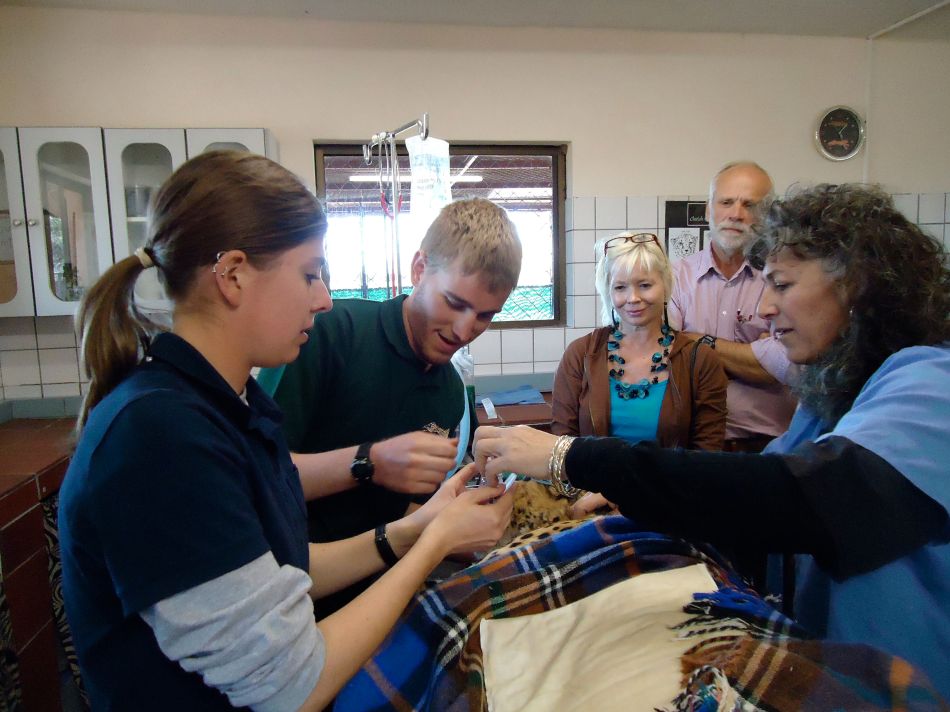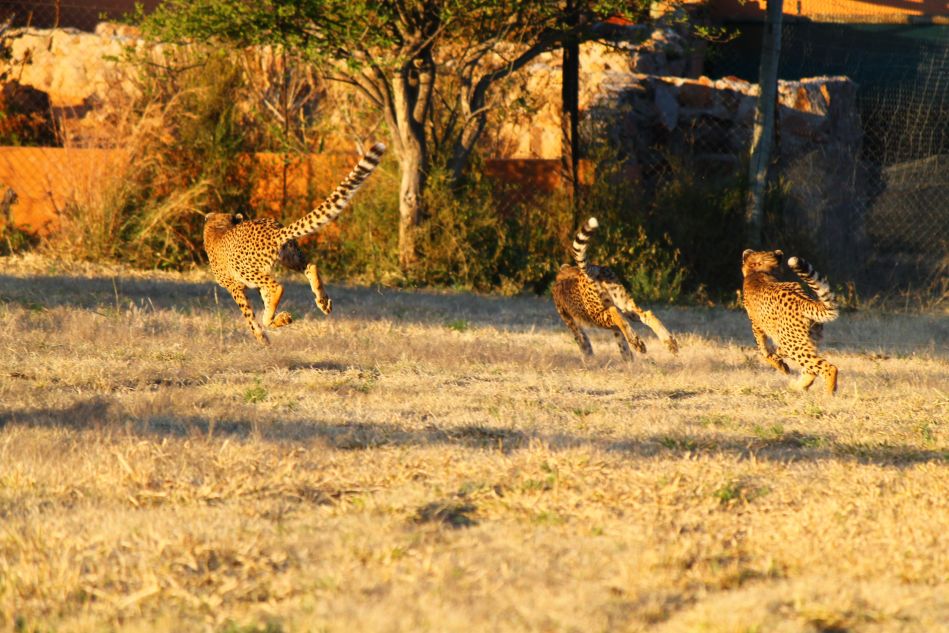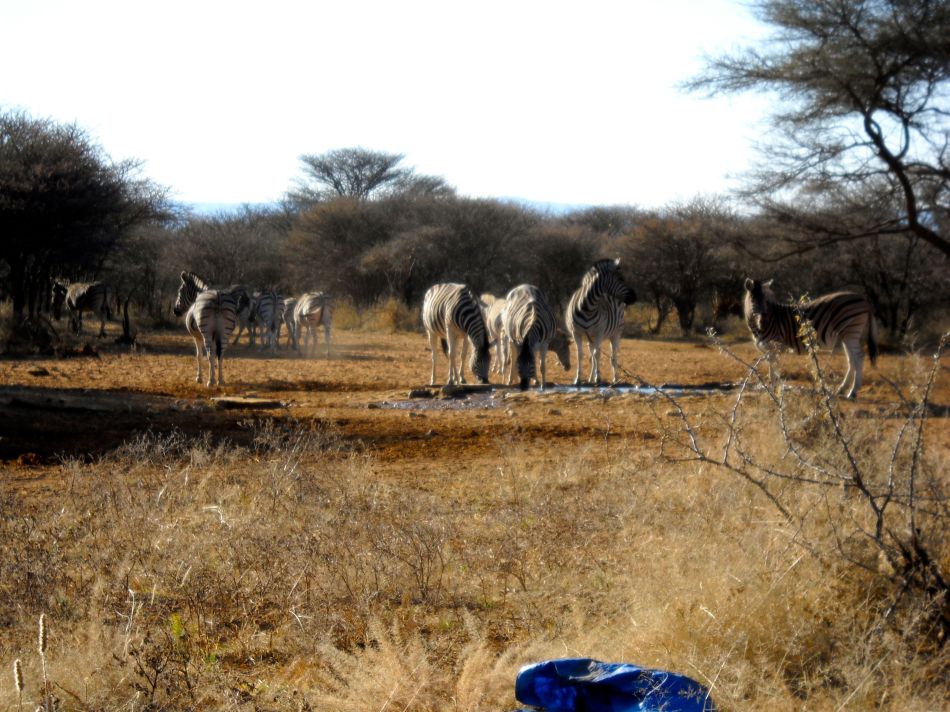Cheetah Workup, 12 Hour Waterhole Count, and Cub Run
I’m in the third week of my internship here at CCF and work has not slowed down at all. We are currently in the middle of an international Conservation Biology course in which we have participants from all over the world including Brazil, Iran, Australia, England, Ethiopia, and Niger. These students work and come from many different areas and professions involving wildlife, but all have a passion for conservation. It is really cool and encouraging to see that people across the world care and are passionate about wildlife and its continued existence on Earth. They are typically busy all day with lectures and practicals, but we get plenty of time to talk and learn about what is going on in other parts of the world. I have met a lot of very interesting people.
Once a year every cheetah at CCF undergoes a medical workup or check up to ensure their health, to diagnose any problems and plan appropriate treatment, and to collect any needed data. These workups typically happen all at once in April but this year, three cheetah workups were postponed for the Conservation Biology course. Last week these 3 cheetahs were anesthetized and brought in for their workup like normal but this time there were students present to learn about how these workups are done. Although this was mainly for the international students, the student interns were involved as well in assisting Dr. Marker and our vet nurse, Rosie, in the workup. It was my first time doing something like that and it was really cool to be involved in that sort of work along side Dr. Marker. We all learned a good deal about how that sort of procedure takes place and the course students really seemed to enjoy it as well.
On Monday we did a cheetah run, but this time we ran the ambassador cubs. These guys are 10 1/2 months old and have a ton of energy so they run exceptionally well. We do it mainly for their health and to help them develop properly, but it is of course a great sight for visitors as well. We are trying to run these guys every three days, there are some of the pictures I took posted below.
Yesterday I went on my first 12 hour waterhole count. We all were dropped off (four pairs) one of four man-made waterholes in Bellebeno camp at 6:00 in the morning. It was our task to observe the waterhole and to count all the animals that came in. Bellebeno is a fenced game camp we use for research, cheetah “soft” releases (the step before release into the wild), and as a food source for our cheetahs. We collect this data in order to understand how the populations within this area are doing so we can establish our own harvest limits and restrictions and to know how the ecosystem is doing as a whole. It was a great experience and was actually relaxing. Twelve hours in a hide is a long time but it went by rather fast and we got to see a bunch of wildlife, including a very large family group of giraffe, which is always great. There are some pictures posted below.
So far things have been great and have been getting even better. There are more pictures below and hopefully I’ll have so more pictures up soon. Please feel free to ask questions or comment. I would be happy to answer any question that anyone may have. Until next time…
-Eli









Hey Eli, this looks amazing!! Beautiful pictures – glad you’re enjoying it!
June 22, 2011 at 7:32 pm
Thanks so much for this comment, it’s so wonderfull to read your day life at CCF.
What is the blue thing on photos?
What is the temperature now at CCF?
Is there some cheetahs’ release on prevision at CCF?
Brigitte
June 23, 2011 at 2:19 am
Your welcome! That was a blue tarp outside of the hide…. I don’t really know why it was there but we need to clean it up. I couldn’t tell you the temperature in celsius but during the day it is probably somewhere in the low 70s farenheit and at night it gets down in the 40s and 30s. Right now there are no releases scheduled but the cats we have at Bellebeno camp are canidates for release so something may be happening in the future with those guys. Hope this answers your questions well enough! -Eli
June 23, 2011 at 4:23 am
Eli, great post and photos! Thanks so much. It is so great to see our interns being so involved and passionate about CCF’s activities.
Patricia – CCF
June 23, 2011 at 1:54 pm
Thank you Patricia!
June 23, 2011 at 2:47 pm
Great shots Eli. I was there 3 1/2 months ao. Fell in love with KaiJay and love that photo pf him flying around so fast. Would you email it to me so I can paint it? Lauriejpeters@gmail.com Thanks
June 23, 2011 at 5:16 pm
Hey Laurie…. if you just click on the image in the blog you can get a much larger version of the image. If that doesn’t work I would be happy to email it to you. I’d love to see the finished product!
June 24, 2011 at 7:37 am
Thanks Eli, for the dedication you put into wildlife conservation! This world needs allot more people like you.
I was doing a little research on Bellebeno and found that the camp is used for Non-Releasable wildlife… Please confirm?..
Where does Bellebeno Camp recieve it’s ‘candidates’ from?
Thanks you again.
Raphi.E
June 24, 2011 at 6:43 am
Where did you find this? From everything I have heard and learned, Bellebeno is the camp we use for the first stage in the release process. However, there are cheetah pens there as well in which we house cheetahs. The cats in those pens are just canidates for release. There would have to be a lot more work and study on those cats before it’s decided if they can actually be released. All of our animals come to us as orphans or injured, so at the time they arrive they are non-releaseable but could be later on in their life. There is no breeding done here at CCF, so no cheetah cubs are born here. I hope this helps!
Eli
June 24, 2011 at 7:33 am
I’ve never heard of Bellebeno before so decided to Google it. Here is the site where I saw it was stated ‘Non-Releasable’; http://www.cheetah.org/ama/orig/CCF_Activity_Rate_Sheet_2011_-_2012.pdf
But if what you say is true, then I’m happy :~)
June 24, 2011 at 8:47 am
Fabulous photography Eli! Thank you for sharing the news on your blog and getting a report of your experiences. Keep it up! Love hearing from you!!
Marisa Katnic’
CCF Southern California Chapter
June 25, 2011 at 2:36 pm